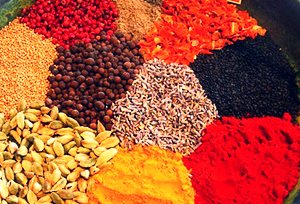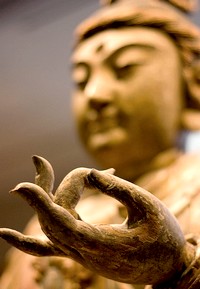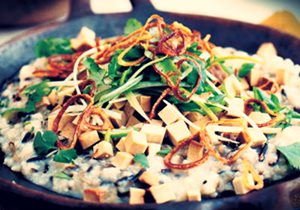What is a Balancing Diet for Vata Dosha?
While there are many things that can aggravate a dosha, food is one of the most influential factors, which we ‘face’ on a daily basis. And, of course, we can use it to our own advantage with the aim of bringing the agitated dosha back to balance.
Food can influence a dosha through tastes and aliment, so to minimize a dosha (in our example here it is Vata), we need to consider, which tastes and foodstuffs to consume.
Best Tastes for Vata Dosha
 According to Ayurveda there are six tastes: sweet, salty, sour, astringent, pungent and bitter. Each taste has its ‘quality’ that affects doshas differently. Sweet, salty and sour tastes are good for Vata, since they reduce it, bringing it to balance (normally we say ‘to balance a dosha’ meaning to reduce its influence on our body and mind). Other three are not favorable since they increase Vata. Of course it does not mean we should drop them from our meal, this is not the case. The point is that when Vata dosha is aggravated, we need to avoid or minimize things that can make it worse.
According to Ayurveda there are six tastes: sweet, salty, sour, astringent, pungent and bitter. Each taste has its ‘quality’ that affects doshas differently. Sweet, salty and sour tastes are good for Vata, since they reduce it, bringing it to balance (normally we say ‘to balance a dosha’ meaning to reduce its influence on our body and mind). Other three are not favorable since they increase Vata. Of course it does not mean we should drop them from our meal, this is not the case. The point is that when Vata dosha is aggravated, we need to avoid or minimize things that can make it worse.
So, if you feel (or have been told to) that your Vata dosha got imbalanced, try to minimize or avoid astringent, pungent and bitter tastes, and increase the consumption of food with sweet, salty and sour tastes. Very simple!
Sweet taste is grounding and nourishing. It’s interesting that we usually prefer to eat sweets at the end of our meals; if we do the opposite, we may spoil our appetite. This is because the sweet taste is the ‘finishing’ taste. It gives you satisfaction. And due to its ‘heavy’ nature, it’s great for Vata dosha.
Among foods that contain this natural ‘sweetness’, are fruits (especially heavy and juicy ones), most grains, most of the dairy products, especially milk, ghee and fresh yogurt, seeds and nuts, most oils.
Keep in mind that adding more of the sweet taste to your meals doesn’t mean to eat more candies, or products containing substantial amounts of refined sugar – actually this may exacerbate Vata even more. Sweet taste should be predominantly natural, and less of the ‘refined’ origin.
Salty taste is very common in almost every regular meal. The taste comes mainly from the salt itself. In general, salt is fine for our health, and it has an ability to emphasize the taste of a dish, but keep in mind that in the majority of Western meals there is too much salt already! So, salt is good for grounding Vata, it retains moisture within the body, it stimulates our digestion and the appetite, helps with elimination, but should be used within reasonable limits!
Sour is a supportive taste, it enliven other flavors, gives energy to the mind and senses, moisten foods, improves digestion and may help with bloating. Among foods, you can find sour taste in green grapes, pineapples, oranges, limes, lemons and grapefruits. The easy solution is to simply squeeze some lemon into a dish, or add a spoon of sour cream or kimchi.
So, what about other tastes?
Bitter taste is cooling, dry and rough by nature, so it is itself similar to Vata qualities, therefore should be minimized to prevent Vata rising in a body. It is contained in bitter greens, chocolate, eggplant, bitter melon and some other veggies.
Pungent taste possesses such qualities as lightness and dryness, which are not suitable for Vata either. It is found in chilies, turnips, radishes and various spices. We should mention that spices in general are good for balancing Vata dosha, but some of them should be taken in moderation.
Astringent taste, although heavy, is also dry, rough and cold, so can make your Vata agitated. It is generally a flavor of dryness (and it is not something we need to prove, right? 😉 ). You can find it in some fruits, veggies, grains and even in some baked foods: pomegranate, apples, artichokes, cranberries, cauliflower, broccoli, lettuce, rice crackers and rye.
By the way, legumes are also mainly astringent in taste, hence the advise for Vatas to reduce their consumption (we are not talking about total cessation of legumes’ presence in your meals; you only need not to indulge yourself too much in eating them 🙂 ), especially black-eyed peas, soybeans, adzuki beans and pinto beans.
Best Tips for Vata Dosha Diet
#1 By Nature, Vata is dry, cool, rough and light, so in order to balance it, you need to consume tastes and food with the opposite qualities: moist, warm, smooth and oily or nourishing. Warm foods are also recommended for Vata Kapha balancing diet.
 #2 Since Vata gets anxious quite easily, taking meals in a peaceful environment is a good idea. It is well known that the condition or emotional state, in which we consume food, increases; so, if your mind is not peaceful, or you are under the stress, it only means nothing good after the meals. Well, yes, actually, sometimes we may become more peaceful after eating, especially if our anxiety is caused by an empty stomach. But, please, keep in mind, that our emotional state will play its role in the process of digestion, so if you are stressed, food will be digested less efficiently, and toxins may accumulate during the process or after it.
#2 Since Vata gets anxious quite easily, taking meals in a peaceful environment is a good idea. It is well known that the condition or emotional state, in which we consume food, increases; so, if your mind is not peaceful, or you are under the stress, it only means nothing good after the meals. Well, yes, actually, sometimes we may become more peaceful after eating, especially if our anxiety is caused by an empty stomach. But, please, keep in mind, that our emotional state will play its role in the process of digestion, so if you are stressed, food will be digested less efficiently, and toxins may accumulate during the process or after it.
#3 Another important thing is how we eat. Ayurveda suggests that we should chew our food long enough – 32 times each peace we put into the mouth. While it may sound like overkill, it actually works. The point is that the food is almost half-digested in your mouth when you chew it long enough; also, the saliva in our mouth possesses antiseptic qualities, which means if there is something in your food, which may cause health problems, it may not make its way inside, if you chew your meal thoroughly.
#4 Routine is essential for grounding Vata dosha, which naturally has a weak digestion. When you take your meals on the same (or almost) time each day, your body will be prepared for that, and the food will be digested better. This, actually, expands itself into almost every aspect of Vata’s life – just remember that routine is good for you. It makes you peaceful and prepared. You can also read about Vata dosha balancing lifestyle.
What to do if I cannot avoid Vata-aggravating foods completely?
#5 Actually, you don’t have to, because it’s almost impossible. All we need to do is to minimize what makes our dosha sick. If you face a Vata-unfriendly dinner, just add something to your meals, which can help it become more ‘Vata-friendly’. It can be a spoon of ghee or olive oil, or a spoon of sour cream. You can add some spices, and always have your meals served warm, not cold.
Daily Meal Examples for Vata Dosha
Let’s start with the breakfast, which is an essential meal for Vata dosha, because your Vata needs nourishment after the ‘night fast’. Breakfast should be hearty and stabilizing, but you should not overeat. The goal of breakfast is to nourish and stabilize Vata right from the start of the day.
One of the best foods for breakfast is hot cereals – things like oatmeal, rice or wheat porridge, cream of wheat or rice pudding. Well, actually you can have other grains as well; just have them well cooked and warm enough. You can cook them in milk if you like and your body allows that. Alternatively you can add some milk or ghee afterwards, once your dish is ready.
Another good ideas is adding some flax seeds or almonds, or honey to your breakfast meals; warming spices like nutmeg, cinnamon, cardamom, cloves and ginger are also great to be added into your dish – either during its cooking or into the ready dish. It’s just an idea – you can adjust your morning meals according to your likes and the knowledge of your predominant doshas. The same is true for other meals during the day.
 Lunch is the main meal of the day, and ideally it should be between noon and 2 pm (12:00-14:00). It is normally the most nourishing, where you can have grains, steamed or sautéed veggies, soups, breads, and even some salad. Mung Dahl is great for soups; among other dish ideas are Basmati rice with chutney or an appropriate sauce, rice pasta, potato soup, vegetables, baked or cooked tofu, etc. There are lots of great dishes for Vata’s lunch.
Lunch is the main meal of the day, and ideally it should be between noon and 2 pm (12:00-14:00). It is normally the most nourishing, where you can have grains, steamed or sautéed veggies, soups, breads, and even some salad. Mung Dahl is great for soups; among other dish ideas are Basmati rice with chutney or an appropriate sauce, rice pasta, potato soup, vegetables, baked or cooked tofu, etc. There are lots of great dishes for Vata’s lunch.
Your dinner can be small and light; at least it should definitely be lighter than lunch. Nevertheless, it has to offer you adequate nourishment. You can have a soup or stew, but in smaller quantities than those from the lunch; or there may be some baked sweet potatoes, served with butter or ghee. Your evening meals should be light, easy to digest but satisfying.
So that’s basically all you need to know about how to organize a balancing diet for Vata dosha. When you have knowledge of basic principles, it’s quite easy to cook the meals that will make your dosha peaceful, clear the mind, and fill your body with the energy of health. Enjoy!
Hi, thank you for the post – this is very helpful. I’ve been trying to eat a Vata balancing diet for a little while now and could use some tips for realistically pulling it off sustainably on a daily basis while making sure I am getting my nutritional and caloric needs met. I’m 6’3” and weigh about 165 pounds but I feel that getting enough calories in a day is often difficult. How many calories should I be consuming for optimum health from an Ayurvedic perspective? Around 2000-2300 seems to be my average. And what should the caloric breakdown be for food – about 1000 grains, 400 legumes, 4-500 oils, 1-200 vegetables? I try to minimize fruit in general, but maybe I need to add calories there instead? I avoid dairy because I have a sensitivity to it. And so for meal breakdowns, it sounds like maybe around 500 calories for breakfast, 1000 for lunch, and 700 for dinner, or something like that?
Hi, Benjamin,
Firstly, why do you care about your calories? I mean it isn’t bad, but normally IF you eat according to your dosha (and your food is diverse enough) you feel satisfied and full of energy, so essentially there is no need to count calories unless you are overweight or have diabetes.
If you feel the lack of calories (as you say), which I guess translates into the lack of energy, then look for the root of the problem in your digestion: is it fine? Do you feel the heaviness in the stomach after your meals? Do you have bloating, gases?
If you do, then it means your food is not properly digested, there are toxins accumulating that draw your energy to themselves.
What to do in this case? Combine your foods carefully, eat always on the same time, do not overeat, and don’t take any meal late in the evening (after 8 pm, and no heavy meals after 6 pm).
Why do you minimize fruit? That’s the nutritional “nuclear bomb” for your body! Fruits have got so many vitamins and minerals in them, but you’d better eat them alone, on empty stomach (with the exception of citrus – they can be eaten after the meals), preferrably in the first half of the day.
So my suggestion would be to fix your digestion if it is poor. And if indeed the digestion is the cause, then firstly do some cleansing (it can be one day fasting on water or juices, or you can take a short Triphala course), then start eating Vata foods in proper combinations, amounts and time.
Hi Denis, Thanks for the detailed reply – that helps a lot. That makes sense that calorie counting is unnecessary – part of me just was a bit worried about undernourishment if I consume too few, but that is probably just left in my head from western influences. My digestion seems generally fine, but my main symptoms are long-term depression, brain fog, lack of emotions, high introversion, and fatigue/low muscle tone. I do fasting on occasion, maybe once every few months for a day, but it does not seem to help too much. I could be better at eating and going to bed at exactly the same time every day (sometimes I eat 4 smaller vs 3 bigger meals a day, and sometimes meal time varies by a couple hours). Sometimes my work schedule makes that difficult, but I can make it more of a priority, since that could be the missing piece. I’ll add a bit more fruit back in and see how it goes. Thanks, again!
You’re welcome, Benjamin!
By the way, regular and adequate physical activity is a good way to fight stress and depression. Try it if you don’t do any.